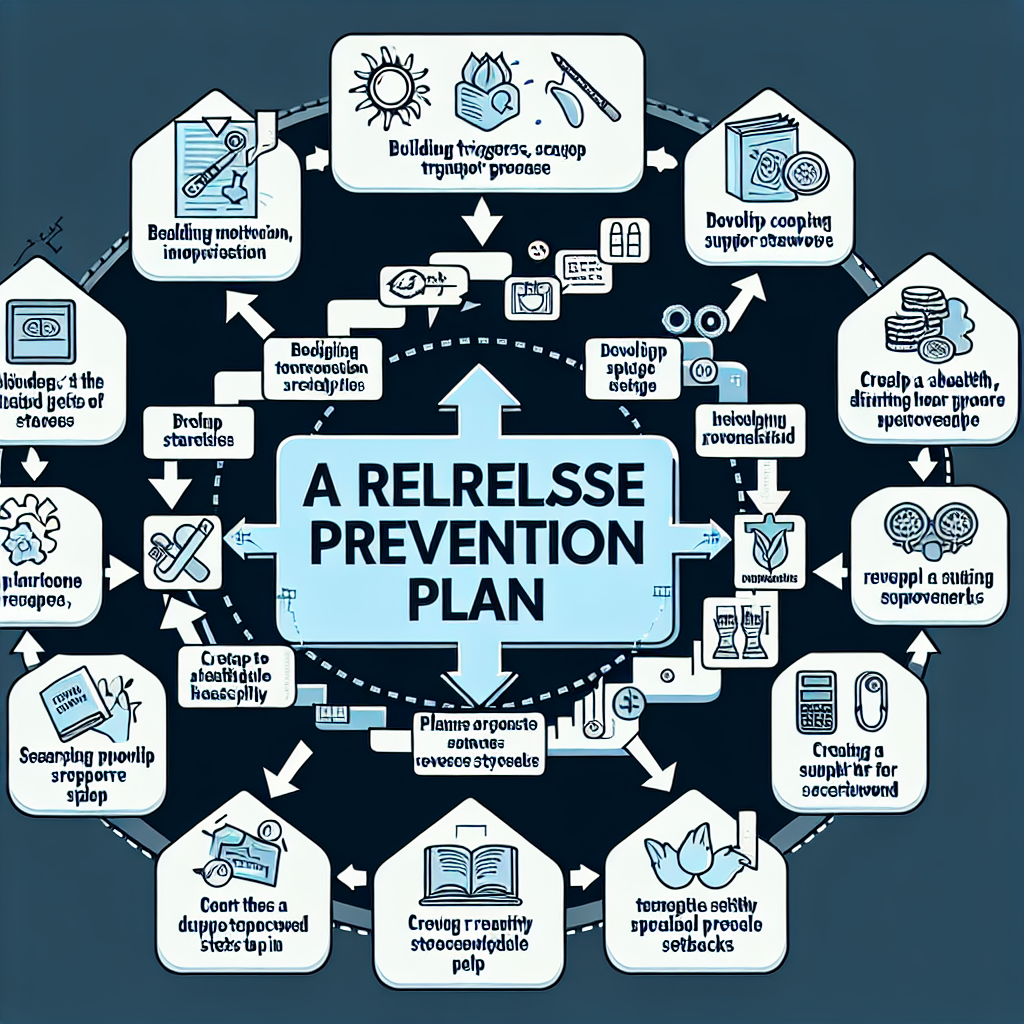-
Table of Contents

“Empower Your Recovery: Crafting a Resilient Relapse Prevention Plan”
Introduction
Developing a relapse prevention plan is a crucial step for individuals recovering from addiction or managing chronic conditions. This plan serves as a proactive strategy to identify potential triggers, cope with cravings, and maintain long-term sobriety or health. It involves understanding personal risk factors, setting realistic goals, and creating a support network. By incorporating techniques such as mindfulness, stress management, and regular self-assessment, individuals can enhance their resilience and reduce the likelihood of relapse. A well-structured relapse prevention plan not only empowers individuals to navigate challenges but also fosters a sense of control and confidence in their recovery journey.
Steps To Create An Effective Relapse Prevention Plan
Creating an effective relapse prevention plan is a crucial step for anyone striving to maintain long-term recovery from addiction. This plan serves as a roadmap, guiding individuals through the challenges and triggers that may arise, and equipping them with the tools needed to stay on track. The first step in developing a relapse prevention plan is to identify personal triggers. These can be people, places, or situations that evoke memories or feelings associated with past substance use. By recognizing these triggers, individuals can take proactive measures to avoid or manage them.
Once triggers are identified, the next step is to develop coping strategies. These strategies are essential for managing cravings and emotional distress without resorting to substance use. Techniques such as mindfulness, deep breathing exercises, and engaging in physical activities can be incredibly effective. Additionally, having a list of supportive contacts, such as friends, family members, or sponsors, can provide immediate assistance when cravings become overwhelming.
Another critical component of a relapse prevention plan is setting realistic and achievable goals. These goals should be specific, measurable, and time-bound, allowing individuals to track their progress and celebrate their successes. For instance, setting a goal to attend a certain number of support group meetings each week can provide structure and accountability. As individuals achieve these goals, their confidence in their ability to maintain sobriety will grow.
In addition to setting goals, it is important to establish a daily routine. A structured routine can help individuals stay focused and reduce the likelihood of encountering triggers. This routine should include time for self-care activities, such as exercise, healthy eating, and adequate sleep, as well as time for hobbies and interests that bring joy and fulfillment. By filling their days with positive and productive activities, individuals can create a sense of purpose and direction.
Furthermore, it is essential to develop a strong support network. Surrounding oneself with positive influences and people who understand the challenges of recovery can provide invaluable encouragement and motivation. Support groups, therapy sessions, and sober living communities can offer a sense of belonging and reduce feelings of isolation. Sharing experiences and learning from others who have faced similar struggles can be incredibly empowering.
Another important aspect of a relapse prevention plan is ongoing education. Staying informed about addiction and recovery can help individuals understand the complexities of their condition and the importance of maintaining their sobriety. Reading books, attending workshops, and participating in online forums can provide valuable insights and keep individuals engaged in their recovery journey.
Lastly, it is crucial to have a contingency plan in place. Despite the best efforts, setbacks can occur, and it is important to be prepared. A contingency plan should outline the steps to take if a relapse happens, such as contacting a sponsor, seeking professional help, or attending an emergency support group meeting. By having a plan in place, individuals can quickly address the situation and minimize the impact of a relapse.
In conclusion, developing an effective relapse prevention plan involves identifying triggers, creating coping strategies, setting achievable goals, establishing a daily routine, building a support network, continuing education, and preparing for setbacks. By taking these steps, individuals can empower themselves to navigate the challenges of recovery and maintain their commitment to a healthier, substance-free life. The journey may be challenging, but with determination and the right plan in place, long-term sobriety is within reach.
Key Components Of A Successful Relapse Prevention Strategy
Developing a relapse prevention plan is a crucial step in maintaining long-term recovery from addiction. A successful strategy involves several key components that work together to provide a robust support system and a clear roadmap for navigating potential challenges. By understanding and implementing these elements, individuals can significantly enhance their chances of sustained sobriety and personal growth.
First and foremost, self-awareness is a fundamental aspect of any relapse prevention plan. This involves recognizing personal triggers and high-risk situations that may lead to a relapse. Triggers can be emotional, such as stress or loneliness, or environmental, like certain places or people associated with past substance use. By identifying these triggers, individuals can develop strategies to avoid or cope with them effectively. For instance, if stress is a significant trigger, incorporating stress management techniques such as mindfulness, meditation, or physical exercise can be incredibly beneficial.
Another critical component is building a strong support network. Recovery is not a journey that should be undertaken alone. Surrounding oneself with supportive friends, family, and peers who understand the challenges of addiction can provide invaluable encouragement and accountability. Support groups, such as Alcoholics Anonymous (AA) or Narcotics Anonymous (NA), offer a sense of community and shared experience that can be particularly empowering. Additionally, having a sponsor or mentor who has successfully navigated recovery can provide guidance and inspiration.
Developing healthy coping mechanisms is also essential. In the past, substances may have been used as a way to cope with difficult emotions or situations. Finding alternative, healthier ways to manage these feelings is crucial for preventing relapse. This might include engaging in hobbies, practicing relaxation techniques, or seeking professional therapy. Cognitive-behavioral therapy (CBT), in particular, has been shown to be effective in helping individuals change negative thought patterns and behaviors associated with addiction.
Setting realistic and achievable goals is another important aspect of a relapse prevention plan. These goals should be specific, measurable, and time-bound, providing a clear sense of direction and purpose. Celebrating small victories along the way can boost motivation and reinforce the commitment to recovery. It is also important to be flexible and adjust goals as needed, recognizing that recovery is a dynamic and ongoing process.
Moreover, maintaining a healthy lifestyle can significantly contribute to relapse prevention. This includes regular physical activity, a balanced diet, and adequate sleep. Physical health and mental well-being are closely interconnected, and taking care of the body can enhance overall resilience and emotional stability. Additionally, avoiding substances that can impair judgment or lower inhibitions, such as alcohol or certain medications, is crucial.
Lastly, having a contingency plan in place for potential setbacks is vital. Relapse is often a part of the recovery journey, and it is important to approach it with a mindset of learning and growth rather than failure. Developing a plan for how to respond to a relapse can help minimize its impact and facilitate a quicker return to recovery. This might involve reaching out to a support person, attending additional meetings, or seeking professional help.
In conclusion, a successful relapse prevention strategy is multifaceted, involving self-awareness, a strong support network, healthy coping mechanisms, realistic goal-setting, a healthy lifestyle, and a contingency plan for setbacks. By integrating these components, individuals can build a solid foundation for long-term recovery, empowering themselves to lead fulfilling and substance-free lives.
Q&A
1. **Question:** What are the key components of a relapse prevention plan?
**Answer:** The key components of a relapse prevention plan include identifying triggers, developing coping strategies, creating a support network, setting realistic goals, and establishing a routine for ongoing self-care and monitoring.
2. **Question:** How can someone identify their triggers for relapse?
**Answer:** Someone can identify their triggers for relapse by keeping a journal to track situations, emotions, and thoughts that lead to cravings or urges, reflecting on past relapses to recognize patterns, and discussing potential triggers with a therapist or support group.
Conclusion
In conclusion, developing a relapse prevention plan involves several key steps: identifying personal triggers and high-risk situations, creating a list of coping strategies, establishing a support network, setting clear and achievable goals, and regularly reviewing and adjusting the plan as needed. By proactively addressing potential challenges and maintaining a structured approach, individuals can significantly enhance their ability to maintain long-term recovery and prevent relapse.



